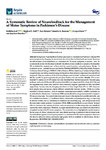A Systematic Review of Neurofeedback for the Management of Motor Symptoms in Parkinson’s Disease
| dc.contributor.author | Anil, K | |
| dc.contributor.author | Hall, S | |
| dc.contributor.author | Demain, S | |
| dc.contributor.author | Freeman, J | |
| dc.contributor.author | Ganis, G | |
| dc.contributor.author | Marsden, J | |
| dc.date.accessioned | 2021-09-29T11:49:30Z | |
| dc.date.issued | 2021-09-29 | |
| dc.identifier.issn | 2076-3425 | |
| dc.identifier.issn | 2076-3425 | |
| dc.identifier.other | ARTN 1292 | |
| dc.identifier.uri | http://hdl.handle.net/10026.1/17973 | |
| dc.description.abstract |
<jats:p>Background: Neurofeedback has been proposed as a treatment for Parkinson’s disease (PD) motor symptoms by changing the neural network activity directly linked with movement. However, the effectiveness of neurofeedback as a treatment for PD motor symptoms is unclear. Aim: To systematically review the literature to identify the effects of neurofeedback in people with idiopathic PD; as defined by measurement of brain activity; motor function; and performance. Design: A systematic review. Included Sources and Articles: PubMed; MEDLINE; Cinhal; PsychoInfo; Prospero; Cochrane; ClinicalTrials.gov; EMBASE; Web of Science; PEDro; OpenGrey; Conference Paper Index; Google Scholar; and eThos; searched using the Population-Intervention-Comparison-Outcome (PICO) framework. Primary studies with the following designs were included: randomized controlled trials (RCTs), non-RCTs; quasi-experimental; pre/post studies; and case studies. Results: This review included 11 studies out of 6197 studies that were identified from the literature search. Neuroimaging methods used were fMRI; scalp EEG; surface brain EEG; and deep brain EEG; where 10–15 Hz and the supplementary motor area were the most commonly targeted signatures for EEG and fMRI, respectively. Success rates for changing one’s brain activity ranged from 47% to 100%; however, both sample sizes and success criteria differed considerably between studies. While six studies included a clinical outcome; a lack of consistent assessments prevented a reliable conclusion on neurofeedback’s effectiveness. Narratively, fMRI neurofeedback has the greatest potential to improve PD motor symptoms. Two main limitations were found in the studies that contributed to the lack of a confident conclusion: (1) insufficient clinical information and perspectives (e.g., no reporting of adverse events), and (2) limitations in numerical data reporting (e.g., lack of explicit statistics) that prevented a meta-analysis. Conclusions: While fMRI neurofeedback was narratively the most effective treatment; the omission of clinical outcome measures in studies using other neurofeedback approaches limits comparison. Therefore, no single neurofeedback type can currently be identified as an optimal treatment for PD motor symptoms. This systematic review highlights the need to improve the inclusion of clinical information and more robust reporting of numerical data in future work. Neurofeedback appears to hold great potential as a treatment for PD motor symptoms. However, this field is still in its infancy and needs high quality RCTs to establish its effectiveness. Review Registration: PROSPERO (ID: CRD42020191097)</jats:p> | |
| dc.format.extent | 1292-1292 | |
| dc.format.medium | Electronic | |
| dc.language | en | |
| dc.language.iso | en | |
| dc.publisher | MDPI | |
| dc.subject | Parkinson's disease | |
| dc.subject | neurofeedback | |
| dc.subject | movement | |
| dc.subject | neural network activity | |
| dc.subject | electroencephalography | |
| dc.subject | neuroimaging | |
| dc.title | A Systematic Review of Neurofeedback for the Management of Motor Symptoms in Parkinson’s Disease | |
| dc.type | journal-article | |
| dc.type | Review | |
| plymouth.author-url | https://www.ncbi.nlm.nih.gov/pubmed/34679358 | |
| plymouth.issue | 10 | |
| plymouth.volume | 11 | |
| plymouth.publication-status | Published online | |
| plymouth.journal | Brain Sciences | |
| dc.identifier.doi | 10.3390/brainsci11101292 | |
| plymouth.organisational-group | /Plymouth | |
| plymouth.organisational-group | /Plymouth/Faculty of Health | |
| plymouth.organisational-group | /Plymouth/Faculty of Health/School of Health Professions | |
| plymouth.organisational-group | /Plymouth/Faculty of Health/School of Psychology | |
| plymouth.organisational-group | /Plymouth/REF 2021 Researchers by UoA | |
| plymouth.organisational-group | /Plymouth/REF 2021 Researchers by UoA/UoA03 Allied Health Professions, Dentistry, Nursing and Pharmacy | |
| plymouth.organisational-group | /Plymouth/REF 2021 Researchers by UoA/UoA04 Psychology, Psychiatry and Neuroscience | |
| plymouth.organisational-group | /Plymouth/REF 2021 Researchers by UoA/UoA04 Psychology, Psychiatry and Neuroscience/UoA04 REF peer reviewers | |
| plymouth.organisational-group | /Plymouth/Research Groups | |
| plymouth.organisational-group | /Plymouth/Research Groups/Centre for Brain, Cognition and Behaviour (CBCB) | |
| plymouth.organisational-group | /Plymouth/Research Groups/Centre for Brain, Cognition and Behaviour (CBCB)/Brain | |
| plymouth.organisational-group | /Plymouth/Research Groups/FoH - Applied Parkinson's Research | |
| plymouth.organisational-group | /Plymouth/Research Groups/Institute of Health and Community | |
| plymouth.organisational-group | /Plymouth/Research Groups/Plymouth Institute of Health and Care Research (PIHR) | |
| plymouth.organisational-group | /Plymouth/Users by role | |
| plymouth.organisational-group | /Plymouth/Users by role/Academics | |
| plymouth.organisational-group | /Plymouth/Users by role/Researchers in ResearchFish submission | |
| dc.publisher.place | Switzerland | |
| dcterms.dateAccepted | 2021-09-27 | |
| dc.rights.embargodate | 2021-12-3 | |
| dc.identifier.eissn | 2076-3425 | |
| dc.rights.embargoperiod | Not known | |
| rioxxterms.versionofrecord | 10.3390/brainsci11101292 | |
| rioxxterms.licenseref.uri | http://www.rioxx.net/licenses/all-rights-reserved | |
| rioxxterms.licenseref.startdate | 2021-09-29 | |
| rioxxterms.type | Journal Article/Review |


